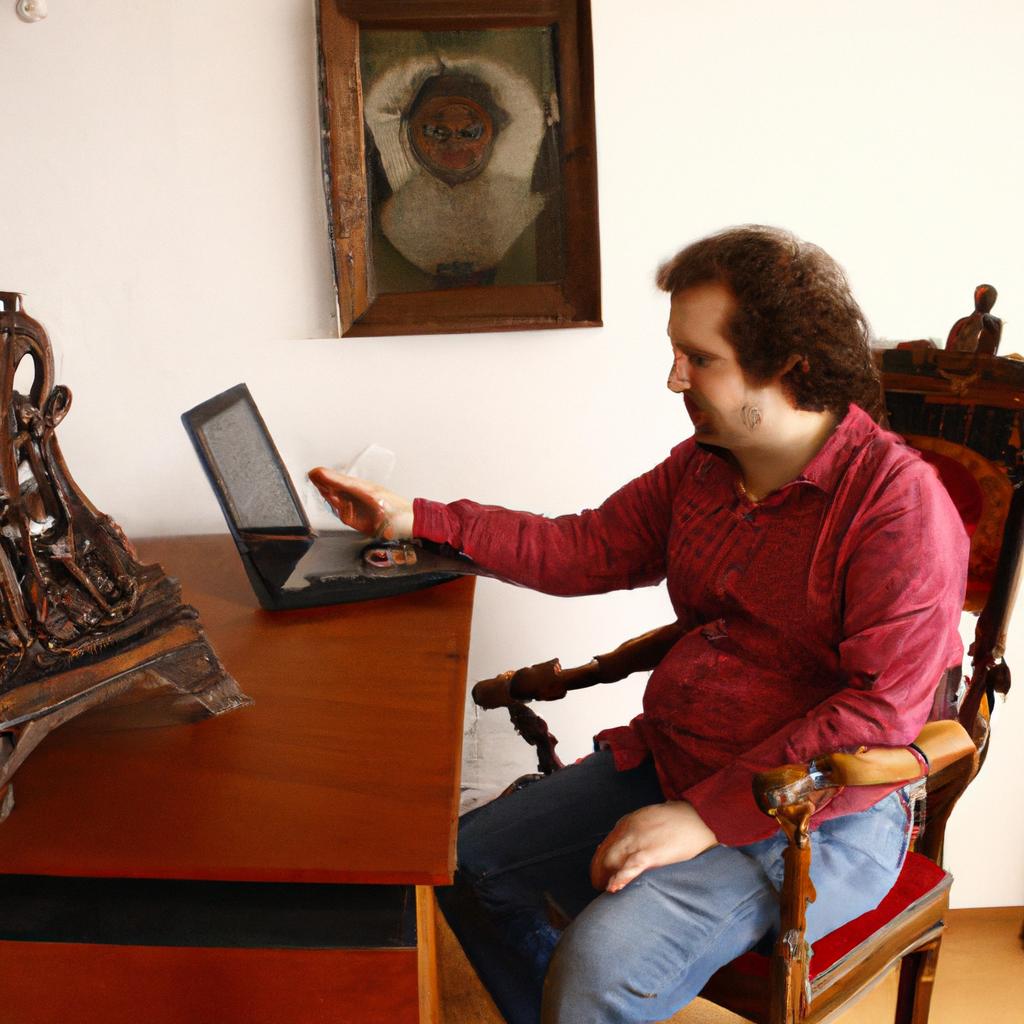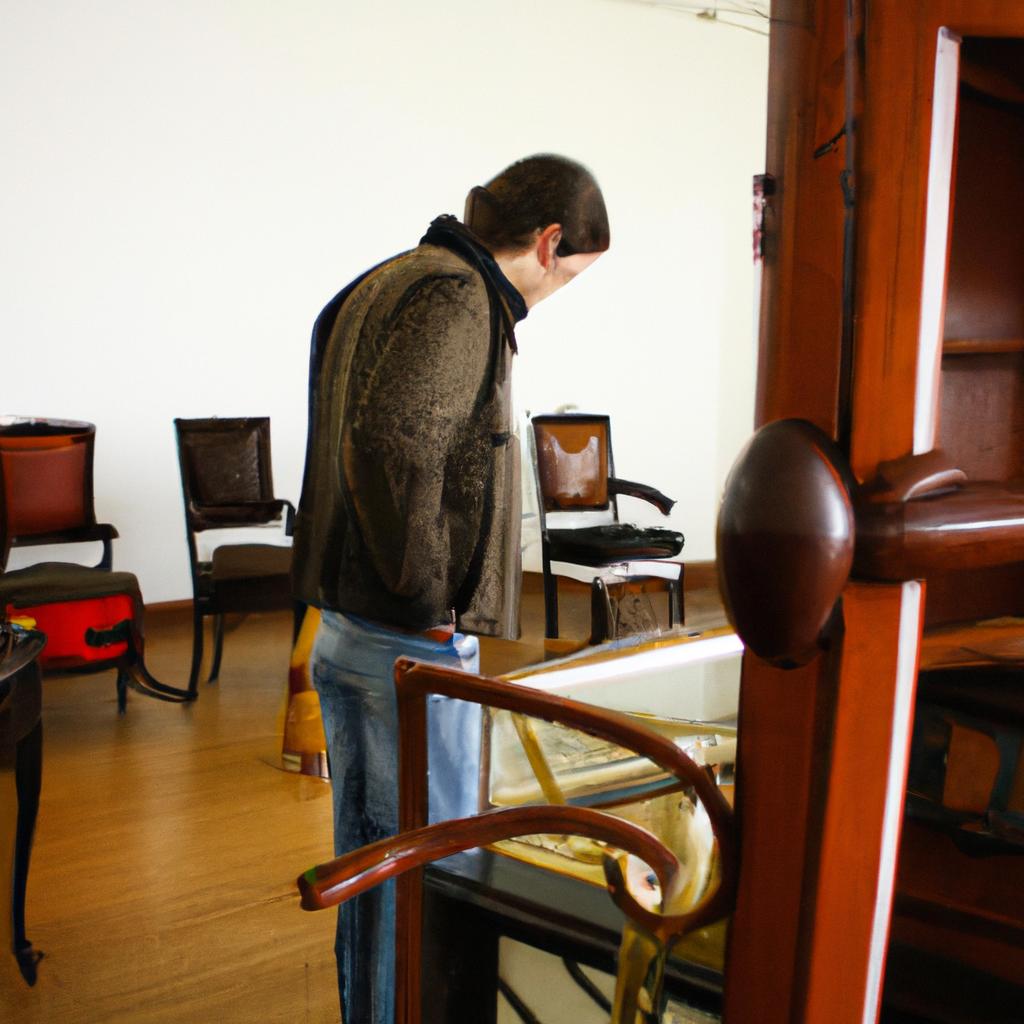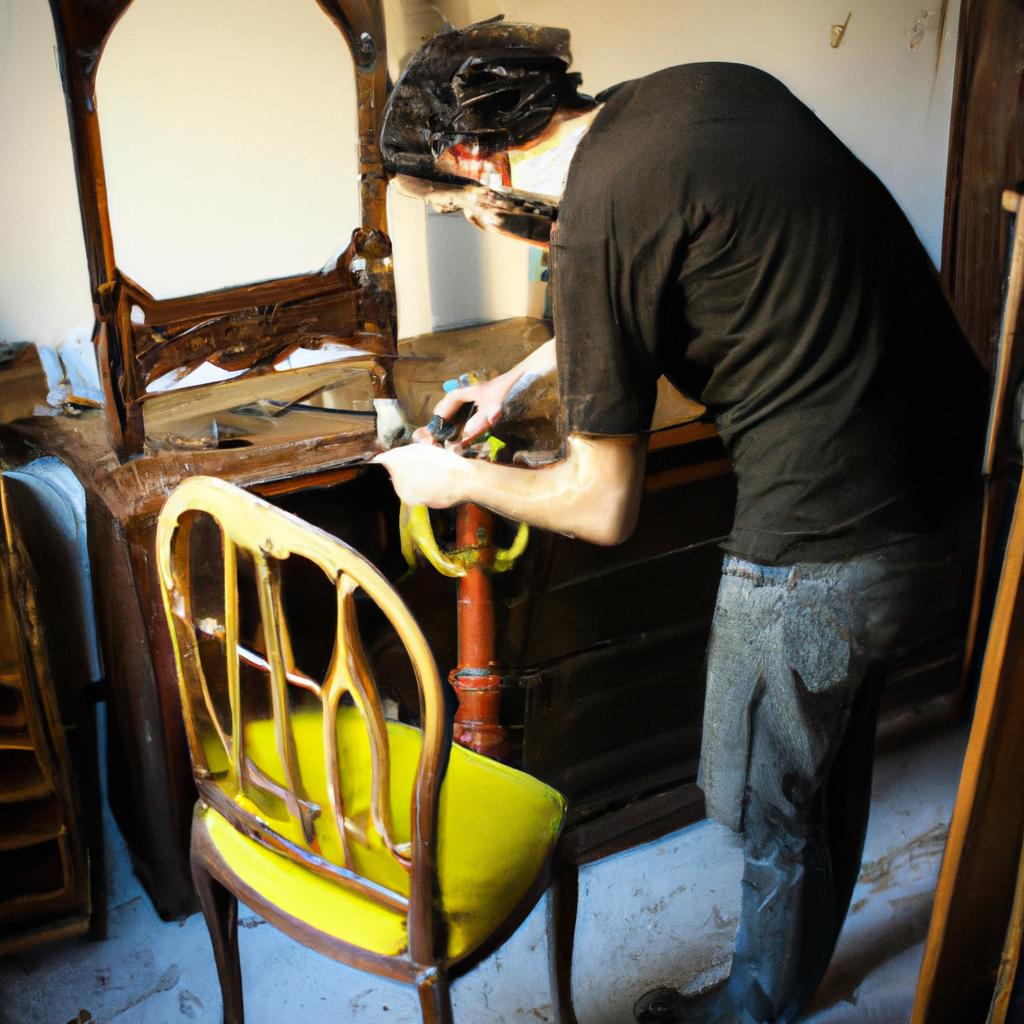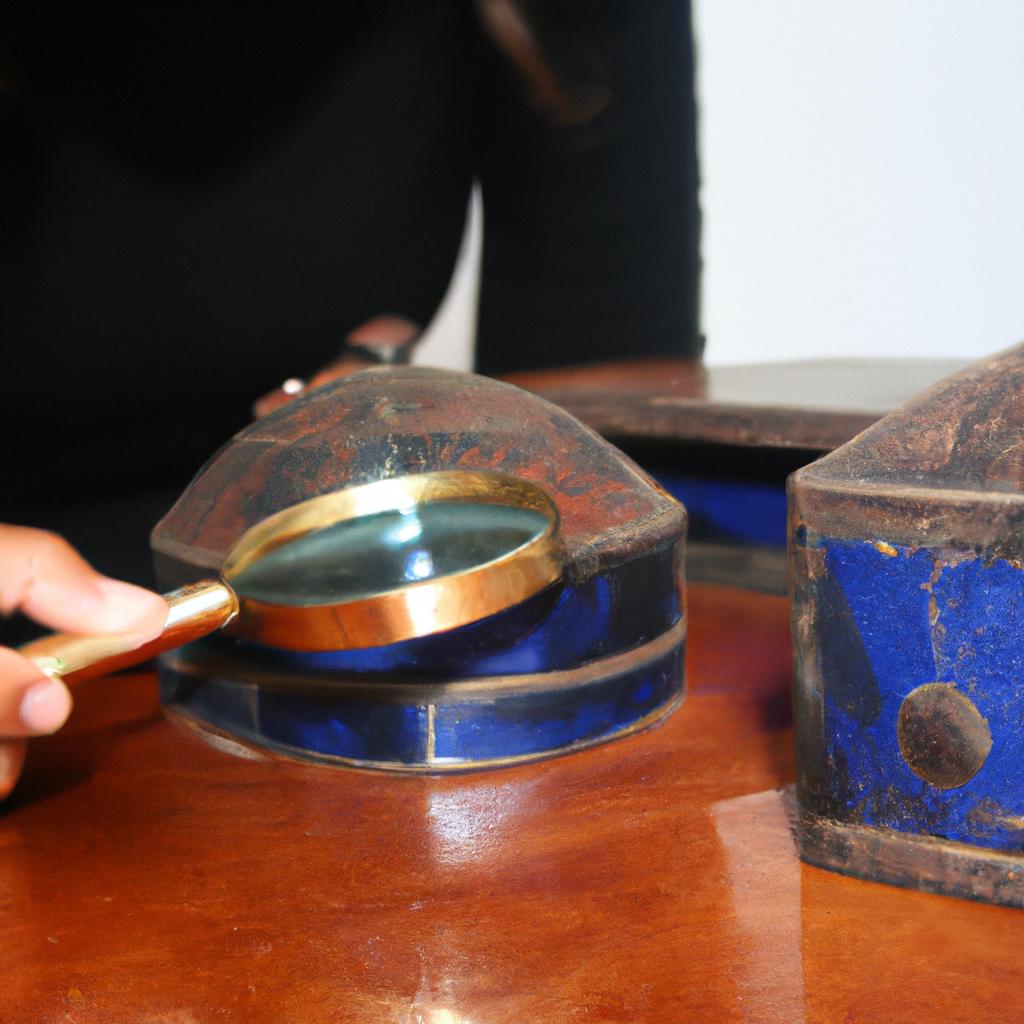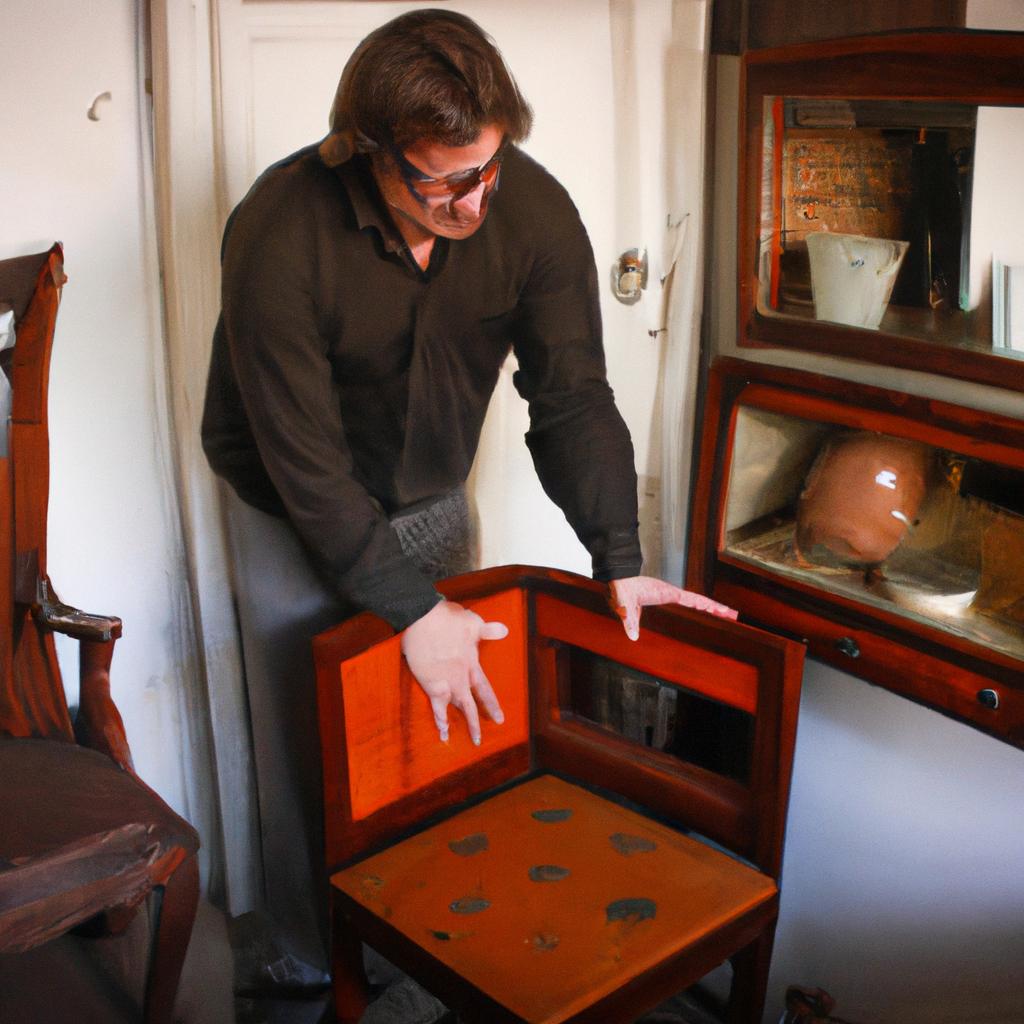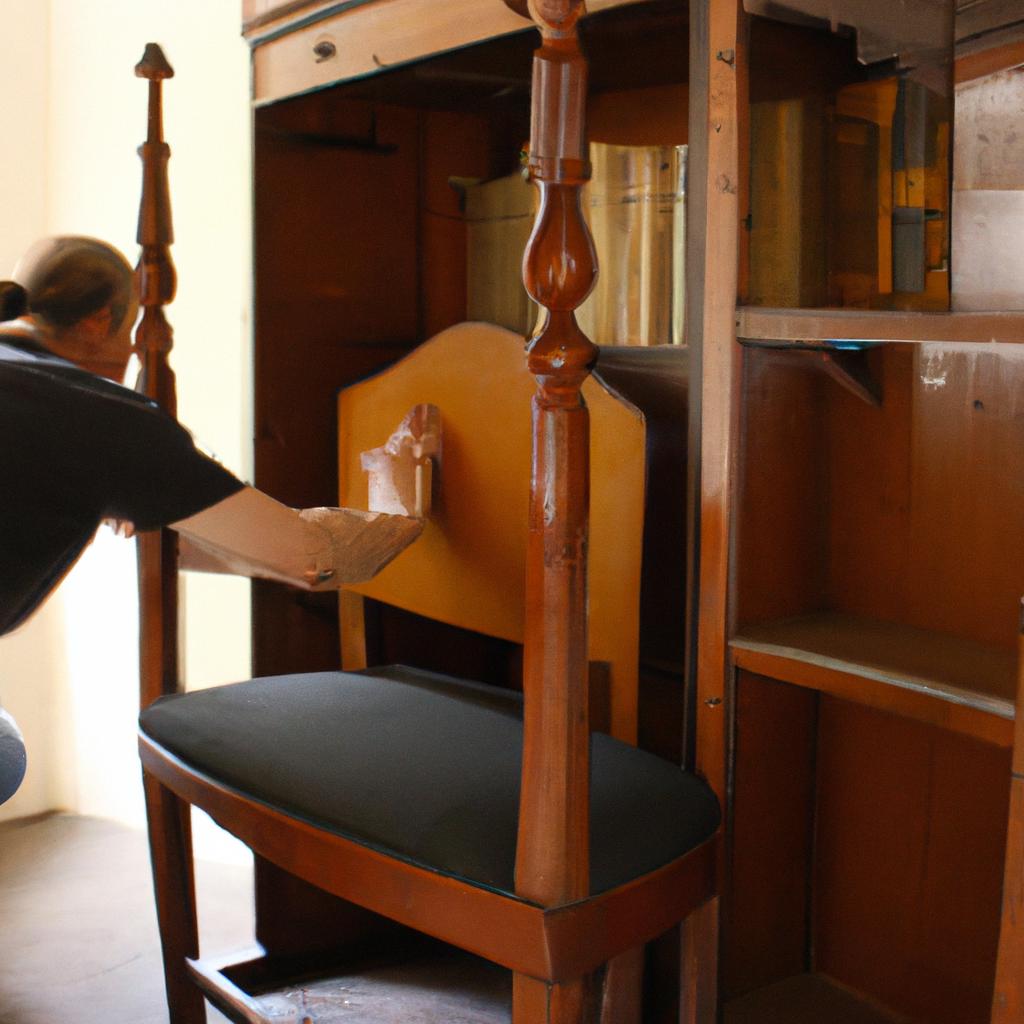Antique Furniture: The Fascinating World of Antiques and Collectibles
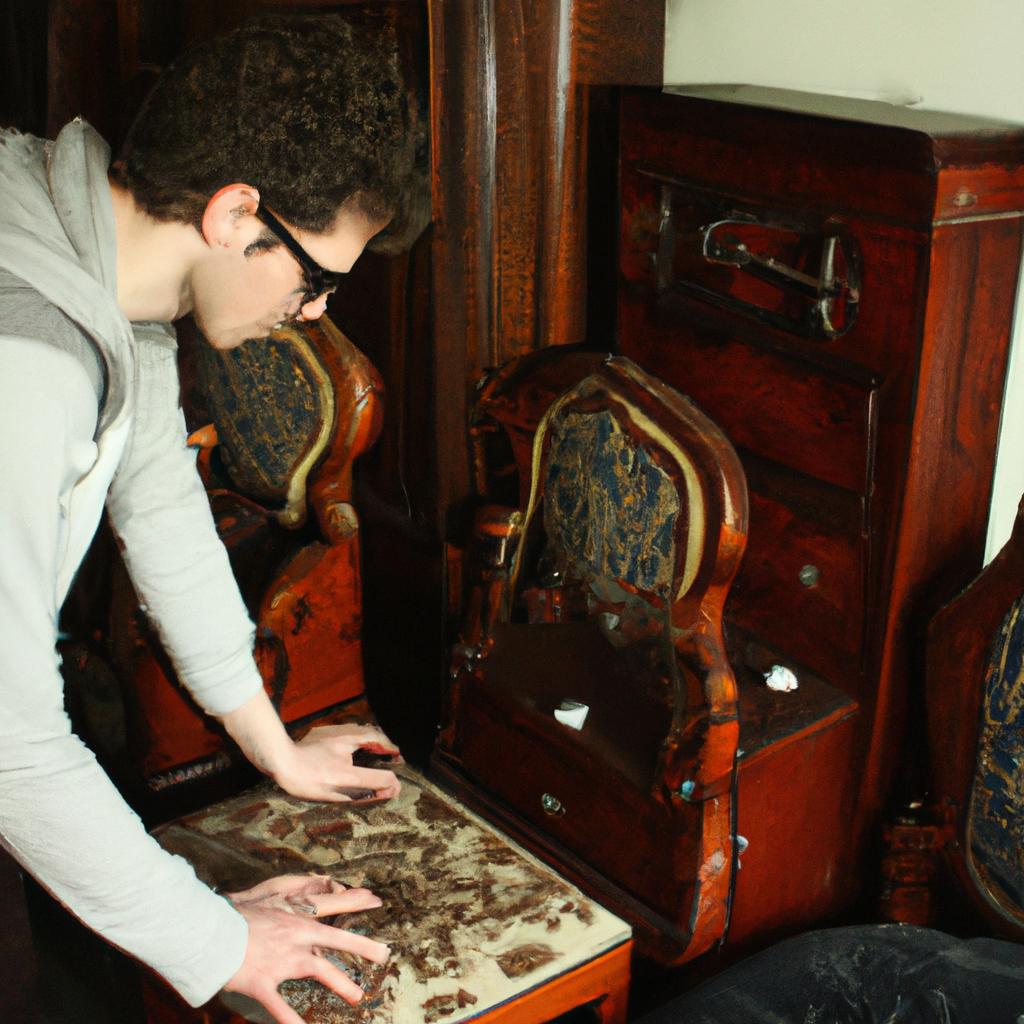
Antique furniture holds a certain allure, captivating the imagination with the stories it carries and the craftsmanship of bygone eras. The world of antiques and collectibles is vast and multifaceted, offering a treasure trove of historical significance, aesthetic beauty, and investment potential to those who delve into its depths. Through this article, we will explore the fascinating realm of antique furniture, uncovering its rich history, highlighting notable pieces, and discussing the intricacies of collecting and preserving these remarkable artifacts.
Consider for a moment a mahogany roll-top desk that once graced the study of an esteemed gentleman in the late 19th century. This elegant piece not only exudes charm but also serves as a tangible link between past and present generations. Antique furniture encompasses various styles like Gothic Revival or Art Deco, each reflecting distinct periods in history and embodying unique design characteristics. By studying these objects closely – their materials, construction techniques, and decorative elements – one can gain insights into social trends and cultural values prevalent at different points in time.
The appeal of antique furniture extends beyond mere aesthetics; it has become an increasingly popular investment option as well. As some contemporary designs lose value over time due to changing tastes or mass production methods, antique pieces maintain their value and often appreciate in worth. This is because antique furniture is typically made with high-quality materials, superior craftsmanship, and limited production numbers, making each piece a rare and coveted find. Additionally, the historical significance and unique stories associated with antiques add to their desirability among collectors.
When it comes to collecting antique furniture, there are various considerations to keep in mind. Firstly, it’s important to educate oneself about different styles, time periods, and makers to make informed purchasing decisions. Researching reputable dealers and auction houses is also crucial to ensure authenticity and fair pricing. It can be helpful to attend antique shows or join collector communities where one can learn from experienced enthusiasts.
Preserving antique furniture requires proper care and maintenance. Factors such as temperature fluctuations, humidity levels, exposure to sunlight, and pests can all impact the condition of these delicate pieces. Regular dusting, polishing with appropriate products, using protective covers or pads on surfaces, and avoiding harsh cleaning agents are some basic steps that can help prolong the life of antique furniture.
In conclusion, antique furniture offers a glimpse into the past while simultaneously providing an avenue for investment and aesthetic enjoyment. The world of antiques is vast and diverse, offering something for every collector’s taste – whether it be a finely carved Victorian armchair or a sleek mid-century modern sideboard. By delving into this fascinating realm with knowledge and care, one can uncover hidden gems that not only beautify living spaces but also tell captivating stories of bygone eras.
Understanding the Value of Vintage Pieces
Antique furniture holds a unique allure for collectors and enthusiasts, as it embodies history, craftsmanship, and an aesthetic appeal that transcends time. To truly appreciate the value of vintage pieces, it is important to delve into their historical context, rarity, condition, and provenance.
For instance, consider a 19th-century mahogany dining table with intricate carvings and exquisite detailing. By examining its origin and craftsmanship, we can gain insights into the historical significance of such a piece. This particular table may have been crafted during a period when skilled artisans meticulously created furniture by hand. Understanding this context adds depth to our appreciation of the item’s value.
When assessing antique furniture’s worth, rarity plays a crucial role. The scarcity or limited availability of certain designs or materials often increases desirability among collectors. For example, an antique desk made from rare wood species like Brazilian rosewood would be highly sought after due to its uniqueness in both design and material composition.
The condition of an antique piece greatly affects its value as well. While some wear and tear are expected given its age, items in good preservation tend to command higher prices than those requiring extensive restoration work. A well-maintained piece retains its original charm intact while showcasing the passage of time through minor imperfections.
To better understand how these factors contribute to valuing antiques effectively, let us explore examples:
- An antique chaise lounge featuring ornate upholstery from the Victorian era evokes nostalgia for a grander past.
- A beautifully crafted Art Deco sideboard adorned with geometric patterns brings forth feelings of glamour and sophistication.
- A delicate tea set passed down through generations carries sentimental value along with its fine china intricacies.
- A sturdy oak bookcase with adjustable shelves offers not only functional storage but also a sense of timeless elegance.
By considering these aspects – historical context, rarity, condition, and personal connection – one can grasp the full extent of an antique piece’s value. In the following section, we will delve into preserving and enhancing antiques to ensure their longevity and continued appreciation as precious heirlooms or investments in our ever-evolving world.
Transitioning into the subsequent section about “Preserving and Enhancing Antiques,” it is vital to explore methods that safeguard these cherished items for future generations while maintaining their aesthetic appeal and historical integrity.
Preserving and Enhancing Antiques
Section H2: Understanding the Value of Vintage Pieces
Antique furniture holds a certain allure for collectors and enthusiasts alike. The value that these vintage pieces possess can be influenced by various factors, including their historical significance, craftsmanship, and condition. By understanding how to assess the worth of antique furniture, individuals can make informed decisions when buying or selling such items.
To exemplify this process, let us consider an intricately carved Victorian-era armchair made from solid mahogany. This chair was crafted in the late 19th century and retains its original upholstery. Its intricate detailing showcases skilled craftsmanship from a bygone era. While it may appear worn with age, its overall condition is remarkable considering its age. Now we will delve into three key aspects to understand the value of vintage pieces.
Firstly, historical significance plays a pivotal role in determining the worth of antique furniture. Items associated with renowned makers or specific periods often command higher prices due to their cultural importance. For instance, a Chippendale-style dining table created during the Georgian period would likely garner more interest than a similar piece produced later on.
Secondly, craftsmanship serves as another crucial factor affecting value. Attention to detail, quality materials used, and precise execution contribute significantly to an item’s desirability among collectors. In our example case study, the intricacy of carving exhibited on the armchair demonstrates exceptional artistry and elevates its appeal.
Thirdly, evaluating the condition of an antique piece is vital in assessing its monetary value accurately. Well-preserved furniture maintained in its original state usually commands higher prices compared to those requiring extensive restoration work. Our Victorian armchair stands out due to its relatively good condition despite being over a century old.
Let us now explore some emotional responses evoked by antiques:
- Nostalgia: Antique furniture often carries sentimental value as they remind individuals of cherished memories from yesteryears.
- Aesthetic Pleasure: The unique charm and beauty of vintage pieces can captivate individuals, adding character to their living spaces.
- Connection with the Past: Owning antiques allows people to feel connected to history, fostering a sense of timelessness and continuity.
- Sense of Exclusivity: The rarity and uniqueness associated with certain antique items create an exclusive appeal for collectors.
Table: Emotional Responses Evoked by Antiques
| Emotion | Description |
|---|---|
| Nostalgia | Elicits sentimental memories from the past |
| Aesthetic Pleasure | Captivates through its unique charm and beauty |
| Connection with the Past | Fosters a feeling of being linked to history |
| Sense of Exclusivity | Creates allure due to rarity and uniqueness |
In conclusion, understanding the value of vintage furniture encompasses considering aspects such as historical significance, craftsmanship, and condition. By carefully evaluating these factors, one can ascertain the worthiness of antique pieces before making any purchasing or selling decisions. In our next section, we will explore how to verify the legitimacy of old treasures in order to avoid potential pitfalls in the world of antiques.
Verifying the Legitimacy of Old Treasures
Having discussed the importance of preserving and enhancing antiques, we now turn our attention to Verifying the Legitimacy of old treasures. To illustrate this process, let us consider the case study of a Victorian-era chair recently acquired by an avid antique collector.
Verification Process:
-
Historical Research:
The first step in verifying the authenticity of an antique is conducting thorough historical research. This involves studying relevant reference materials, examining similar pieces from the same era, and consulting experts in the field. In our example, the collector discovered that chairs from the Victorian period often featured intricate carvings and upholstery made with luxurious fabrics such as velvet or silk. -
Physical Examination:
Once preliminary research has been conducted, a physical examination of the item becomes crucial. By closely inspecting every detail – from its construction techniques to any existing markings or labels – one can gain valuable insights into its age and origin. Our collector found distinct hand-carved motifs on the chair’s legs and backrest, consistent with other genuine examples from the Victorian era. -
Technical Analysis:
In some cases, further technical analysis might be necessary to confirm an antique’s authenticity. Advanced methods like carbon dating or X-ray imaging can provide scientific evidence regarding its age, materials used, and potential restoration work undertaken over time. However, it is important to note that these procedures should only be carried out by qualified professionals to avoid damaging fragile artifacts.
- The thrill of uncovering hidden stories behind cherished heirlooms.
- The satisfaction derived from safeguarding cultural heritage for future generations.
- The sense of awe when realizing how craftsmanship has evolved throughout history.
- The joy experienced when connecting with others who share a passion for antiquities.
Emotional Response – Table:
| Emotion | Description | Example |
|---|---|---|
| Curiosity | A desire to explore the unknown and learn more about historical artifacts. | Wondering how an antique piece was made or who owned it in the past. |
| Nostalgia | Fond memories or sentiments associated with a particular time period. | Feeling nostalgic while gazing at a vintage photograph album. |
| Appreciation | Recognizing the value and beauty of artistry from bygone eras. | Admiring the intricate details on an Art Nouveau vase. |
By thoroughly verifying the legitimacy of old treasures, collectors can ensure they are acquiring genuine antiques that hold both historical significance and aesthetic value. In our next section, we will delve into exploring the market for vintage items, where enthusiasts can discover unique pieces to add to their collections without delay.
Exploring the Market for Vintage Items
Having discussed the importance of verifying the legitimacy of old treasures, let us now delve into the exciting world of exploring the market for vintage items. To illustrate this point further, consider a hypothetical scenario where an antique enthusiast named Sarah stumbles upon an intriguing item at a local flea market.
Paragraph 1:
Sarah’s eyes are immediately drawn to a beautifully crafted Victorian-era dresser that exudes elegance and charm. Intrigued by its potential value, she embarks on an exploration of the vintage market to gain insights into its worth. In her quest, she uncovers several fascinating aspects about buying and selling vintage items:
- Niche Markets: The vintage market encompasses various niche sectors catering to different types of collectors. From antique furniture enthusiasts like Sarah to avid coin collectors or rare book aficionados, each sector offers a distinct set of valuable items waiting to be discovered.
- Online Platforms: The rise of e-commerce has revolutionized how people engage with the vintage market. Online platforms such as dedicated antique websites, auction houses, and social media groups have made it easier than ever for individuals like Sarah to connect with sellers from around the world.
- Price Fluctuations: Just like any other market, prices in the vintage industry can fluctuate significantly based on factors such as demand, rarity, and condition. Understanding these dynamics is crucial when making informed decisions as both buyers and sellers.
Paragraph 2:
To provide a comprehensive overview of what awaits aspiring collectors in the world of vintage items, we present a table below showcasing some popular categories along with their distinctive characteristics:
| Category | Distinctive Characteristics |
|---|---|
| Antique Jewelry | Precious metals adorned with gemstones |
| Vintage Clothing | Unique designs from specific eras |
| Retro Electronics | Iconic gadgets from past decades |
| Collectible Toys | Limited edition items with nostalgic value |
This table merely scratches the surface of the vast array of vintage categories available, enticing collectors to explore and uncover hidden gems.
Paragraph 3:
As Sarah continues her journey through the market for vintage items, she excitedly anticipates what lies ahead. With a multitude of niche markets to explore, online platforms at her fingertips, and an understanding of price fluctuations, she feels equipped to navigate this captivating world. In our next section on “Finding Hidden Gems at Auctions,” we will delve deeper into one particular avenue that holds great promise for unearthing rare treasures: auctions.
With Sarah’s newfound knowledge in tow, let us now venture into the exhilarating realm of finding hidden gems at auctions.
Finding Hidden Gems at Auctions
Imagine stumbling upon an old dusty attic, filled with forgotten treasures from a bygone era. Amongst the cobwebs and boxes lies a worn-out wooden chair, its intricate carvings hinting at a rich history. This captivating discovery exemplifies the allure of antique furniture and the fascinating world of antiques and collectibles. As we delve deeper into this realm, let us explore how one can navigate the market for vintage items.
When it comes to buying antique furniture, understanding the various avenues available is crucial. Auctions provide an exciting opportunity to uncover hidden gems brimming with historical significance. These events attract collectors, enthusiasts, and dealers alike who eagerly bid on unique pieces that may be centuries old. Additionally, estate sales offer a chance to acquire heirloom-quality items directly from families or estates downsizing their possessions. Online platforms have also revolutionized the way people buy antiques, providing access to a global marketplace at our fingertips.
To make informed decisions while venturing into this world of antiquities, it is essential to consider several factors:
- Rarity: Rare pieces tend to hold higher value due to their scarcity in the market.
- Condition: The overall condition of an item significantly affects its desirability and potential restoration costs.
- Provenance: A well-documented history or association with notable figures enhances an object’s value and appeal.
- Style and Design: Certain periods or styles may experience fluctuations in demand over time.
Table 1: Factors Influencing Antique Furniture Value
| Factor | Description |
|---|---|
| Rarity | Scarcity increases value |
| Condition | Well-preserved items are highly sought after |
| Provenance | Historical connections elevate worth |
| Style and Design | Trends impact desirability |
By considering these aspects when evaluating potential purchases, individuals can better navigate the complex landscape of antique furniture acquisition. Whether seeking a unique addition to an existing collection or embarking on a new passion for antiques, understanding the market and its intricacies is paramount.
Transitioning into the subsequent section about “Navigating the digital marketplace,” we will explore how technology has transformed the way people engage with antique furniture.
Navigating the Digital Marketplace
Antique Furniture: The Fascinating World of Antiques and Collectibles
Section H2: Finding Hidden Gems at Auctions
Having explored the excitement of finding hidden gems at auctions, let us now turn our attention to another avenue that provides ample opportunities for antique enthusiasts – navigating the digital marketplace. In this section, we will delve into how online platforms have revolutionized the way collectors search for and acquire antique furniture.
In today’s interconnected world, online marketplaces have become a treasure trove for antique hunters seeking unique pieces from different eras. One such example is Emma, an avid collector based in New York City. With a passion for Victorian-era furniture, she turned to virtual platforms like AntiqueFinds.com to expand her collection beyond what local auctions could offer.
The advantages of exploring the digital marketplace are manifold:
- Vast selection: Online platforms provide access to a wide array of antique furniture options spanning various styles and time periods.
- Global reach: Buyers can connect with sellers from around the world without being limited by geographical boundaries.
- Enhanced research capabilities: Shoppers can conduct thorough background checks on items they are interested in through advanced search filters and detailed descriptions.
- Competitive pricing: Due to increased competition among sellers, prices tend to be more competitive compared to physical stores or Auction Houses.
To illustrate the convenience and possibilities offered by these online marketplaces, consider the following table showcasing some popular websites catering specifically to antique furniture lovers:
| Website | Description | Notable Features |
|---|---|---|
| AntiqueFinds.com | A leading platform specializing in antiques | User-friendly interface |
| RetroRevival.co.uk | British-based website focusing on retro items | Expert authentication process |
| EuroVintage.net | European-centric site offering vintage finds | Multilingual customer support |
| TimelessTreasures.com | A diverse selection of antique furniture | Regular auctions and bidding capabilities |
By embracing the digital marketplace, collectors like Emma have uncovered rare and valuable finds that would otherwise remain undiscovered. The convenience of online browsing coupled with the ability to connect with sellers globally has broadened horizons for enthusiasts in their quest for unique pieces.
Now, let us delve deeper into the world of unearthing these remarkable treasures as we explore strategies for identifying rare and valuable antiques.
Unearthing Rare and Valuable Finds
Uncovering Hidden Gems: The Thrill of Antique Hunting
Imagine stumbling upon an old dusty attic, filled with forgotten treasures and relics from a bygone era. As you cautiously explore the space, your eyes lock onto an intricately carved wooden chair that seems to whisper stories of its past. This captivating experience is at the heart of antique hunting – a thrilling journey through time that allows collectors to uncover hidden gems and connect with history in a tangible way.
One such example is the case of Emma Johnson, an avid antique enthusiast who stumbled upon a remarkable find during her exploration of estate sales. She discovered an exquisite Victorian-era dressing table adorned with delicate hand-painted flowers and ornate brass handles. Despite its initial neglected state, Emma recognized its true value and embarked on a restoration project that transformed the piece into a stunning centerpiece for her home.
The allure of antique hunting lies not only in the discovery of unique objects but also in the emotions it evokes. Here are some reasons why this pursuit can be so enticing:
- Nostalgia: Antiques often carry sentimental value, reminding us of cherished memories or providing glimpses into our cultural heritage.
- Aesthetic Appeal: The craftsmanship and attention to detail found in antique furniture can be breathtaking, offering a level of beauty rarely seen in mass-produced modern pieces.
- Investment Potential: Certain antiques appreciate in value over time, making them attractive assets for those seeking financial gain while indulging their passion for collecting.
- Sustainable Consumption: By purchasing pre-owned items rather than new ones, antique hunters contribute to reducing waste and promoting environmentally-friendly practices.
To further illustrate the diverse range of antiques available and their potential impact on one’s surroundings, consider the following table showcasing different styles and their characteristics:
| Style | Characteristics | Example |
|---|---|---|
| Art Deco | Sleek lines, geometric patterns | Mirrored console table |
| Renaissance | Elaborate carvings, rich colors | Carved oak dining chairs |
| Mid-Century Modern | Clean lines, organic forms | Eames lounge chair and ottoman |
| Victorian | Ornate details, floral motifs | Walnut bookcase with leaded glass |
As antique hunters immerse themselves in this captivating world of discovery, they not only add unique pieces to their collections but also breathe new life into forgotten treasures. The subsequent section will delve into the art of restoring antiques to their former glory, exploring techniques that preserve the integrity and beauty of these remarkable artifacts.
Restoring Antiques to Their Former Glory
Imagine stumbling upon an old, dusty attic filled with forgotten treasures. As you carefully navigate through the cobwebs and piles of discarded items, your eyes catch a glimpse of something extraordinary—a beautifully carved antique chair that exudes elegance and craftsmanship from a bygone era. This captivating discovery is just one example of how the world of antique furniture offers a gateway into history, culture, and art.
Delving deeper into this fascinating realm unveils a multitude of reasons why people are drawn to collecting antiques. Here are four compelling aspects that ignite excitement in collectors:
- Historical Significance: Antique furniture serves as tangible links to our past, providing glimpses into different periods and styles throughout history. Each piece holds its own story, carrying traces of previous owners’ lives and experiences.
- Artistic Beauty: From intricately carved wooden details to exquisite upholstery work, antique furniture showcases the skillful artistry of craftsmen who dedicated hours upon hours to create unique pieces that transcend time.
- Unique Design: Unlike mass-produced modern furniture, antiques possess a distinct character and charm that cannot be replicated. The individuality found in these pieces adds personality and depth to any interior space.
- Investment Potential: Many collectors view antique furniture as not only aesthetically pleasing but also as valuable assets that can appreciate over time. With proper care and preservation, rare finds have the potential to become highly sought after by enthusiasts and investors alike.
To fully appreciate the allure of antique furniture, let us explore some notable examples across various styles:
| Style | Key Features | Notable Examples |
|---|---|---|
| Rococo | Ornate carvings; curved lines | Louis XV Commode |
| Georgian | Symmetry; refined proportions | Chippendale Wingback Chair |
| Arts & Crafts | Handcrafted; natural materials | Gustav Stickley Sideboard |
| Art Deco | Geometric shapes; luxurious finishes | Le Corbusier LC2 Armchair |
The diverse range of styles and their respective features exemplify the artistic variety found within antique furniture. Whether you are captivated by the intricate details of Rococo or the sleek lines of Art Deco, there is something for every collector’s taste.
As we continue our exploration into the world of antiques, it becomes evident that authenticating these treasures is paramount to understanding their true worth. In the subsequent section on “Authenticating Antique Art and Decor,” we will delve deeper into the process of determining an item’s authenticity and its importance in preserving our cultural heritage.
Authenticating Antique Art and Decor
Restoring Antiques to Their Former Glory: A Time-Intensive Process
Imagine stumbling upon a dilapidated antique chair at a local flea market. Its once elegant frame is now covered in layers of dust and its upholstery tattered beyond recognition. At first glance, it may seem like an insurmountable task to restore such a piece back to its former glory. However, with the right knowledge and expertise, restoring antiques can be a rewarding endeavor that brings these treasures back to life.
Restoration of antiques requires meticulous attention to detail and patience. Each piece comes with its own set of challenges, whether it’s dealing with structural issues or preserving delicate finishes. Take for instance the aforementioned chair; restoring it would involve assessing the condition of its frame, repairing any loose joints or broken parts, cleaning off years’ worth of grime, reupholstering the seat cushion, and finally applying appropriate finishes or polishes. This process demands not only technical skills but also an understanding of historical restoration methods.
To successfully restore an antique to its former glory, one must follow several key steps:
- Assessment: Begin by carefully examining the piece to identify areas that require repair or replacement.
- Repair: Address structural issues such as loose joints or damaged components using appropriate techniques or seeking professional help if needed.
- Cleaning: Remove dirt, grime, and old finishes without damaging the original surface through gentle cleaning methods.
- Finishing: Apply suitable finishes that match the era and style of the antique while ensuring long-term preservation.
The table below showcases some common restoration challenges encountered when working on different types of antiques:
| Type of Antique | Restoration Challenge |
|---|---|
| Wooden Furniture | Repairing cracks and splits in wood |
| Porcelain Figurines | Reattaching broken pieces seamlessly |
| Silverware | Removing tarnish without affecting intricate designs |
| Oil Paintings | Restoring faded or damaged paint layers |
The process of restoring antiques is a labor-intensive one, requiring expertise and dedication. By investing the necessary time and effort, antique enthusiasts can bring these timeless pieces back to their former splendor.
Transitioning into the next section about “The Art of Buying and Selling Old Objects,” it becomes apparent that understanding the restoration process also plays a crucial role in evaluating the authenticity and value of antiques. By delving into the world of Authenticating Antique Art and Decor, collectors gain valuable insights that enable them to make informed decisions when acquiring or selling such objects.
The Art of Buying and Selling Old Objects
Imagine stumbling upon a beautifully crafted antique dresser at a local flea market. Its intricate carvings, solid wood construction, and rich history make it an object of desire for collectors and enthusiasts alike. However, before delving into the world of buying and selling antiques, it is essential to understand the intricacies involved in this process.
When considering purchasing or selling old objects, there are several key factors one must take into account. First and foremost, it is crucial to conduct thorough research on the item’s provenance and authenticity. For instance, let us consider a hypothetical scenario where you come across an antique vase that appears to be from the Ming Dynasty. By consulting reputable sources such as auction catalogs, expert opinions, or historical records, you can determine whether the piece is genuine or a well-made reproduction.
Once authenticity has been established, another vital aspect to consider is its condition. Antiques often exhibit signs of wear or damage due to their age; however, the degree of preservation significantly impacts their value. A scratched painting may require restoration by professionals trained in art conservation techniques to bring it back to its former glory. Alternatively, an untouched piece with minimal wear might command a higher price among collectors seeking originality.
Furthermore, understanding current market trends and demand plays a pivotal role when buying or selling antiques. Collectors’ tastes evolve over time, influencing which objects hold substantial monetary value in any given period. Keeping abreast of these changing preferences allows sellers to target potential buyers effectively while ensuring they offer fair prices for sought-after items.
Emotional bullet point list
To fully appreciate the significance of acquiring and parting with antique treasures:
- Experience the thrill of uncovering hidden gems buried beneath layers of dust.
- Embrace nostalgia as each artifact carries stories from generations past.
- Revel in the satisfaction of finding rare pieces that enrich personal collections.
- Witness history come alive through the preservation of these timeless objects.
| Emotions | Experiences |
|---|---|
| Excitement | Discovering hidden gems |
| Nostalgia | Reliving stories from generations past |
| Satisfaction | Acquiring rare pieces for personal collections |
| Enchantment | Witnessing history come alive |
In summary, buying and selling antiques require comprehensive knowledge about the object’s authenticity, condition, and market demand. By conducting meticulous research and staying attuned to changing trends, individuals can navigate this intricate world with confidence.
Transition sentence into subsequent section: Understanding the intricacies involved in appraising antique objects is fundamental for both buyers and sellers alike.
The Role of Appraisal Services in the Antique Industry
Section Title: Unveiling the Rich History of Antique Furniture
Antique furniture possesses a captivating allure that transcends time, providing us with glimpses into bygone eras. To truly appreciate these treasures, it is essential to delve into their rich history and understand the intricate details that make them so remarkable. This section will explore the origins of antique furniture, its evolution over centuries, and its significance in today’s world.
One fascinating example illustrating the historical importance of antique furniture is the case study of an intricately carved Victorian chair. Crafted during the 19th century, this piece reflects the opulence and elegance prevalent in that era. The meticulous carvings on its wooden frame tell tales of skilled artisans who painstakingly created each intricate detail by hand. Such examples exemplify how antique furniture serves as tangible links to our past, offering valuable insights into cultural norms, artistic styles, and craftsmanship techniques.
The journey of antique furniture spans vast periods and encompasses diverse styles influenced by different regions and cultures. From ancient Egypt’s ornate chests to Renaissance Italy’s exquisite cabinets adorned with marquetry, every period has left behind distinctive imprints on this art form. Each design element tells a story – be it the graceful curves characteristic of French Rococo or the sleek lines epitomizing Art Deco. Exploring these variations provides a deeper understanding of societal shifts, technological advancements, and changing aesthetics throughout history.
Considering the enduring appeal of antique furniture, it comes as no surprise that collectors avidly seek out pieces with exceptional value and rarity. Acquiring such objects can offer both financial rewards and emotional fulfillment for enthusiasts passionate about preserving history through material artifacts. Here are four reasons why individuals are drawn to collecting antique furniture:
- Connection to the past: Owning a piece from another era establishes a personal connection with history.
- Unique aesthetic charm: Antique furniture often boasts distinct designs not commonly found in contemporary pieces.
- Investment potential: Certain antique furniture items can appreciate in value over time, making them appealing financial assets.
- Environmental consciousness: Choosing antiques promotes sustainability by reducing the demand for mass-produced furniture.
To visually highlight the diversity of antique furniture styles and their potential impact on collectors, consider the following table:
| Style | Time Period | Key Features |
|---|---|---|
| Chippendale | 18th century | Elaborate carvings |
| Art Nouveau | Late 19th to early | Organic forms |
| 20th century | ||
| Biedermeier | Early to mid-19th | Clean lines and simplicity |
| century | ||
| Louis XVI | Late 18th century | Neoclassical influences |
The rich history and diverse appeal of antique furniture continue to captivate enthusiasts worldwide. In our next section, we will explore the thrill that comes with uncovering these cherished relics—unearthing hidden gems from forgotten pasts—a journey that invigorates both experienced collectors and newcomers alike.
[Transition into the subsequent section about “The Thrill of Discovering Antique Treasures”] As we delve deeper into the enchanting world of antiquities, a sense of excitement builds within us as we embark upon an adventure brimming with untold stories and undiscovered treasures.
The Thrill of Discovering Antique Treasures
Building on the importance of appraisal services, we now turn our attention to the thrill that comes with discovering antique treasures. In this section, we explore the excitement and fascination associated with unearthing valuable relics from the past.
Antique enthusiasts are often driven by a desire to uncover hidden gems that hold historical significance and monetary value. Imagine stumbling upon an old wooden chest in your attic, covered in layers of dust and forgotten over time. Curiosity piques as you open it, revealing a collection of intricately carved ivory figurines dating back to the 18th century. This exhilarating moment encapsulates the essence of treasure hunting within the world of antiques.
To further illustrate this tantalizing experience, consider these emotions commonly felt when making such discoveries:
- Awe: The sheer beauty and craftsmanship exhibited in these objects can leave one awestruck.
- Intrigue: Unfolding the stories behind each piece fuels a sense of curiosity about its origins and previous owners.
- Nostalgia: Antique items often evoke memories of times gone by, transporting us back to different eras.
- Satisfaction: The satisfaction derived from finding something rare or unique is unparalleled.
| Emotion | Description |
|---|---|
| Awe | Overwhelming admiration for the beauty and skill displayed |
| Intrigue | Fascination sparked by untold stories waiting to be uncovered |
| Nostalgia | Sentimental connections evoked through memories attached to objects |
| Satisfaction | Fulfillment gained from acquiring rare or exceptional finds |
In conclusion, exploring the realm of antique treasures offers a captivating journey filled with awe-inspiring moments. From admiring exquisite craftsmanship to unraveling mysterious histories, each discovery brings forth a range of emotions. As collectors and enthusiasts continue their quests for elusive artifacts, they remain enchanted by both the physical allure and sentimental meaning embedded within these timeless relics.

